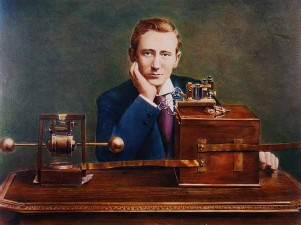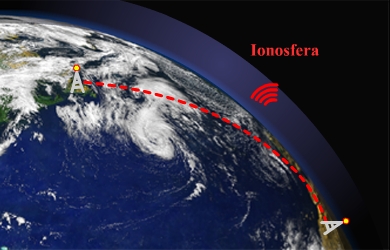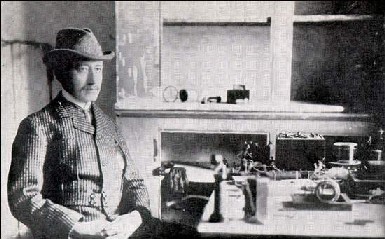Guglielmo Marconi (continued)
|
|
 |
| Fig. 1: Marconi at work in 1896, after arriving in England. |
The first experiments with radio transmissions
Marconi obtained his first results using two metallic reflectors: types of concave metal dishes placed one in front of the other. This idea had in fact already been used by Hertz and Righi to send and receive electromagnetic waves over greater distances.
By replacing the metallic reflectors with electric wires placed vertically and - with great intuition - by experimenting with new instruments for reception and transmission, in the spring of 1895 he made what is considered to be the first radio transmission. The signals were sent from Villa Griffone and were received one kilometre away.
|
|
The two posts were not in view of each other, being separated by Celestini Hill, so Marconi’s brother and a local farmer who were waiting over the hill had arranged to let Guglielmo know if they received the signal by firing a shotgun. Alfonso fired the shot and history was made!
Marconi immediately tried to involve the Italian government in the financial enterprise, but they did not understand the enormous implications of the discovery.
He therefore moved to England to stay with his cousin, the engineer Henry Jameson Davis, who introduced him into British scientific and industrial circles. In England, on 2 June 1896, he patented his invention and continued his experiments, including the successful transmission of signals across the Bristol Channel, a distance of about 15 km.

Fig. 2: Diagram showing waves
"reflected" by the
ionosphere (in fact they are repeatedly refracted until they return to earth) in
Marconi's transatlantic transmission. Click on the figure for animation
(download Flash Player [here] if necessary).
(Credit: Davide Centomo, Dip. di
Fisica Università di Bologna)
Marconi's great technical success was the first transatlantic transmission on 12 December 1901. At the St. John receiver station on Signal Hill in Newfoundland, Marconi received in his headphones a triple signal – the letter "S" of the morse code made up of three dots – emitted from the transmitting station of Poldhu in Cornwall.
 |
|
| Fig. 2: Drawing
of airborne wire aerial used at Signal Hill to receive the first
transatlantic radio transmission on 12 December 1901. (Credit: Marconi Jubilee 1897-1947, Chelmsford, England: Marconi's Wireless Telegraph Company Limited, 1947) |
Despite the scepticism of physicists and great mathematicians, including H. Poincaré, regarding the possibility of transmitting radio signals over such a long distance due to the curvature of the Earth, the transmission was a success. By gaining confidence with tests over increasingly greater distances, Marconi had used the properties of the ionosphere (unknown of at the time) in order to reflect the long waves of radio signals. If he had listened to those learned scholars instead of his instinct he would not even have carried out the experiment!
 |
| Fig. 3: Marconi in Newfoundland, at the station where the first transatlantic radio transmission was received in 1901. |
So, at the age of only 27, Marconi became famous all over the world.
|
|

